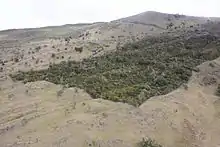Land restoration
Land restoration, which may include renaturalisation or rewilding, is the process of ecological restoration of a site to a natural landscape and habitat, safe for humans, wildlife, and plant communities. Ecological destruction, to which land restoration serves as an antidote, is usually the consequence of pollution, deforestation, salination or natural disasters. Land restoration is not the same as land reclamation, where existing ecosystems are altered or destroyed to give way for cultivation or construction. Land restoration can enhance the supply of valuable ecosystem services that benefit people.

Repairing damaged land
Land restoration can include the process of cleaning up and rehabilitating a site that has sustained environmental degradation, such as those by natural cause (desertification) and those caused by human activity (strip mining), to restore that area back to its natural state as a wildlife home and balanced habitat.
Countering desertification

Land reclamation in deserts involves
- setting up reliable water provisioning (e.g. by digging wells or placing long-distance water pipes)
- stabilizing and fixating the soil
Stabilizing and fixating the soil is usually done in several phases.
The first phase is fixating the soil to such extent that dune movement is ceased. This is done by grasses, and plants providing wind protection such as shelterbelts, windbreaks and woodlots. Shelterbelts are wind protections composed of rows of trees, arranged perpendicular to the prevailing wind, while woodlots are more extensive areas of woodland.[1]
The second phase involves improving/enriching the soil by planting nitrogen-fixating plants and using the soil immediately to grow crops. Nitrogen fixating plants used include clover, yellow mustard, beans, etc., and food crops include wheat, barley, beans, peas, sweet potatoes, date, olives, limes, figs, apricot, guava, tomato, certain herbs, etc. Regardless of the cover crop used, the crops (not including any trees) are each year harvested and/or plowed into the soil (e.g. with clover). In addition, each year the plots are used for another type of crop (known as crop rotation) to prevent depleting the soil on specific trace elements.
A recent development is the Seawater Greenhouse and Seawater Forest. This proposal is to construct these devices on coastal deserts in order to create fresh water and grow food.[2] A similar approach is the Desert Rose concept.[3] These approaches are of widespread applicability, since the relative costs of pumping large quantities of seawater inland are low.[4]
Another related concept is ADRECS – a proposed system for rapidly delivering soil stabilisation and re-forestation techniques coupled with renewable energy generation.[5]
See also
- Land rehabilitation
- Environmental restoration
- Reforestation, Forest restoration, Forest landscape restoration
- Restoration ecology
- Farmer-managed natural regeneration
- Floodplain restoration
- Riparian zone restoration
- Stream restoration
- Daylighting (streams)
- Mine reclamation
- Soil salinity control, restoration of saline land
- Bonn Challenge
- Rewilding (conservation biology)
References
- Desert reclamation
- The Sahara Project a new source of freshwater food and energy
- Desert Rose - Claverton Group Energy Conference, Bath October 2008
- "what power is needed to pump seawater to the middle of the Gobi Desert for desalination in the SeaWater Greenhouse?".
- http://www.claverton-energy.com/download/320/%5B%5D
External links
- "Degraded Land Restoration". Regeneration.org. 2021.
- "Global Restoration Initiative". World Resources Institute.
- "The Bonn Challenge".
The Bonn Challenge is a global aspiration to restore 150 million hectares of the world's deforested and degraded lands by 2020